 In the intro-outro last time we mentioned that we were pondering on what exactly to take to the Chiltern Hills Rusty Club Show. In an unlikely twist of fate our problem was solved for us. Well, in true live-for-the-moment fashion, we got a mail from Jeff Lawton to ask if we would like to come and see the Hurricane his brother Phil is currently restoring. ‘He’s over for the weekend, Can you be at Thruxton for 10.30 Sunday?’ it read. John would be miffed as he was away for the weekend. ‘Could we take some piccies?’ we asked. ‘No problem’, replied Jeff. We called Barry, he hit the A41 on the ‘urry-up. We pushed the Whippet back in the Shed and in glorious sunshine, by nine, we were heading for Thruxton. Now these days Thruxton is best known as a Racetrack and the name is widely used in connection with various marques of motorcycle, car, engine and silencer and I’ve certainly seen some fine motorcycling there over the years but it is also a very active airfield somewhat jammed between a large amount of Controlled Airspace. In 1941, rather appropriately, it was also home to 225 Squadron then equipped with Hurricanes so where more appropriate to find one.
In the intro-outro last time we mentioned that we were pondering on what exactly to take to the Chiltern Hills Rusty Club Show. In an unlikely twist of fate our problem was solved for us. Well, in true live-for-the-moment fashion, we got a mail from Jeff Lawton to ask if we would like to come and see the Hurricane his brother Phil is currently restoring. ‘He’s over for the weekend, Can you be at Thruxton for 10.30 Sunday?’ it read. John would be miffed as he was away for the weekend. ‘Could we take some piccies?’ we asked. ‘No problem’, replied Jeff. We called Barry, he hit the A41 on the ‘urry-up. We pushed the Whippet back in the Shed and in glorious sunshine, by nine, we were heading for Thruxton. Now these days Thruxton is best known as a Racetrack and the name is widely used in connection with various marques of motorcycle, car, engine and silencer and I’ve certainly seen some fine motorcycling there over the years but it is also a very active airfield somewhat jammed between a large amount of Controlled Airspace. In 1941, rather appropriately, it was also home to 225 Squadron then equipped with Hurricanes so where more appropriate to find one.
I have to confess to being a little unsure of what we would see in terms of its current state but as Jeff often gave us updates on the progress of this incredibility bold project, and we had learnt last time he visited that they were hoping to have it airworthy by July 2013, surely it must be pretty well finished but, as always, these things are relative. What we saw when we entered through the back door of Pheonix Aero Services’ hangar was truly spectacular. A spontaneous intake of breath followed! The wings were off as with both on it wouldn’t fit, and anyway they were still being finished, but none-the-less the vision was pure nostalgia. We were looking at the unmistakeable shape of a Hurricane in all its glory.
 Now before we go into great detail about the stunning quality of this amazing rebuild which, with around 40% being original parts, it actually is, rather than a new build, which most are, here is a bit about the history of this particular Canadian Car & Foundry Hurricane IIB construction number R30040. Hurricanes always get passed by in favour of the Spitfire but its contribution to the Battle of Britain was enormous and, flat out, it wasn’t that much slower than the equivalent Spitfire of the time. Hurricanes and its components were built by many different companies during the war years and this one was built, as the manufacturer’s name suggests, in Canada and entered service with the Royal Canadian Airforce in 1941 with 127 Squadron carrying number 5487 and based in Gander. On the 22nd November 1942 at 22.30, whilst carrying out night time aerobatics (sounds like our sort of bloke), Flight Sgt A R Taylor managed to stuff it into a large snowdrift near Indian Bay, Newfoundland. Miraculously he managed to bale out and escaped with minor injuries but the Hurricane was not so fortunate and after a lot of head scratching it was declared a write-off in March 1943. To all intents and purposes it then vanished until Suffolk-based Hawker Restorations acquired the remains in the mid 1990s. They in turn flogged it to Classic Aero Engineering on Thruxton Airfield in 2002 where it was registered as G-CBOE and they set about rebuilding it. Unfortunately they ceased trading in 2011. With his own Hurricane being rebuilt and short of parts and this one now at a halt Phil got involved and decided to take on the task of finishing it with the intention of eventually using the proceeds from the sale, some of the extra parts and the expertise gleaned from the build to get his own Hurricane back in the air. Checking G-INFO, somewhat strangely, it turns out one of the former share-holders lives in the Old Mill in Wendover. How odd is that?
Now before we go into great detail about the stunning quality of this amazing rebuild which, with around 40% being original parts, it actually is, rather than a new build, which most are, here is a bit about the history of this particular Canadian Car & Foundry Hurricane IIB construction number R30040. Hurricanes always get passed by in favour of the Spitfire but its contribution to the Battle of Britain was enormous and, flat out, it wasn’t that much slower than the equivalent Spitfire of the time. Hurricanes and its components were built by many different companies during the war years and this one was built, as the manufacturer’s name suggests, in Canada and entered service with the Royal Canadian Airforce in 1941 with 127 Squadron carrying number 5487 and based in Gander. On the 22nd November 1942 at 22.30, whilst carrying out night time aerobatics (sounds like our sort of bloke), Flight Sgt A R Taylor managed to stuff it into a large snowdrift near Indian Bay, Newfoundland. Miraculously he managed to bale out and escaped with minor injuries but the Hurricane was not so fortunate and after a lot of head scratching it was declared a write-off in March 1943. To all intents and purposes it then vanished until Suffolk-based Hawker Restorations acquired the remains in the mid 1990s. They in turn flogged it to Classic Aero Engineering on Thruxton Airfield in 2002 where it was registered as G-CBOE and they set about rebuilding it. Unfortunately they ceased trading in 2011. With his own Hurricane being rebuilt and short of parts and this one now at a halt Phil got involved and decided to take on the task of finishing it with the intention of eventually using the proceeds from the sale, some of the extra parts and the expertise gleaned from the build to get his own Hurricane back in the air. Checking G-INFO, somewhat strangely, it turns out one of the former share-holders lives in the Old Mill in Wendover. How odd is that?
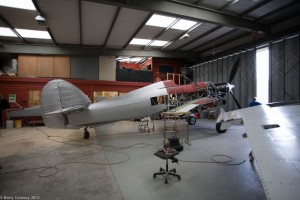 The work to date is impressive to say the least. It is actually quite incredible. Its rare to get to see any classic aircraft with so much detail exposed and it really brings home the complexity of rebuilding something on this scale never mind being able to see and appreciate the construction methods originally used. Phil explained that the scarcity of parts and documentation various for the bulk of the Warbirds that are either flying or under build is pretty rare so there is an enormous amount of favour gaining and giving that goes on to either borrow components to copy or use as templates for a rebuild or the acquisition of otherwise vanished parts.
The work to date is impressive to say the least. It is actually quite incredible. Its rare to get to see any classic aircraft with so much detail exposed and it really brings home the complexity of rebuilding something on this scale never mind being able to see and appreciate the construction methods originally used. Phil explained that the scarcity of parts and documentation various for the bulk of the Warbirds that are either flying or under build is pretty rare so there is an enormous amount of favour gaining and giving that goes on to either borrow components to copy or use as templates for a rebuild or the acquisition of otherwise vanished parts.  All around the hangar were bits and bobs off of other aircraft either in damaged or restored form that were used to supply bits or as guides for the rebuild. Drawings are all well and good, and Phil has managed to get hold of most of them for the Hurricane, but having a finished part to hand makes all the difference. That isn’t to say there is also a large cottage industry making one-off items from individual brackets and manifolds to wing sections that keep these increasingly rare aircraft in the air. The actual skills in bending and forming skins for the wings or re-assembling the bits and bobs is equally challenging and becoming a dieing art but Phil’s team is incredibly skilled and he has even found a retired panel maker who, on their own in-house press, has made up all the panel work needed largely by eye without patterns to copy. A rare skill indeed.
All around the hangar were bits and bobs off of other aircraft either in damaged or restored form that were used to supply bits or as guides for the rebuild. Drawings are all well and good, and Phil has managed to get hold of most of them for the Hurricane, but having a finished part to hand makes all the difference. That isn’t to say there is also a large cottage industry making one-off items from individual brackets and manifolds to wing sections that keep these increasingly rare aircraft in the air. The actual skills in bending and forming skins for the wings or re-assembling the bits and bobs is equally challenging and becoming a dieing art but Phil’s team is incredibly skilled and he has even found a retired panel maker who, on their own in-house press, has made up all the panel work needed largely by eye without patterns to copy. A rare skill indeed.
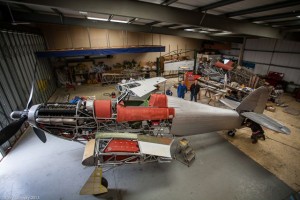 The almost overwhelming enormity of the challenge is the most impressive aspect. Over the years I have been presented with many boxes of bits and bobs and asked to get them back into a working wotsit without drawings or even pictures and that is task enough but this is on a whole new scale. The trouble is that although you may have manuals and drawings coming out your ears assembly from ‘new’ is a whole different ball game. Construction guides don’t exist so components have to go in and out several times before the correct order of assembly can been ascertained. Then of course there is all the component and material testing, sourcing the correct grade of steel originally used and re-finishing items before re-fitting and naturally the Civil Aviation Authority insist on overseeing the whole thing. Despite all this the Hurricane is almost there now.
The almost overwhelming enormity of the challenge is the most impressive aspect. Over the years I have been presented with many boxes of bits and bobs and asked to get them back into a working wotsit without drawings or even pictures and that is task enough but this is on a whole new scale. The trouble is that although you may have manuals and drawings coming out your ears assembly from ‘new’ is a whole different ball game. Construction guides don’t exist so components have to go in and out several times before the correct order of assembly can been ascertained. Then of course there is all the component and material testing, sourcing the correct grade of steel originally used and re-finishing items before re-fitting and naturally the Civil Aviation Authority insist on overseeing the whole thing. Despite all this the Hurricane is almost there now. 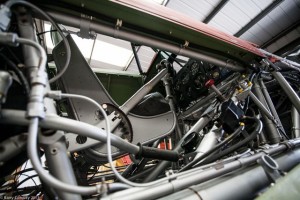 The Cockpit is now all in and the controls in place back to its basic military specification. The trim and access panelling just needs to go back and the two new wings finishing. Refitting the wings is a three hour job. What about the engine? The Merlin that now sits in it is all shiny and newly overhauled with zero hours having been acquired from a Spanish Airforce Hienkel (yes they did, check out the film Battle of Britain) and fitted with a modern pre-oiler to ensure a healthy oil presence is there from the word go, the Merlin being dry sump, for those that were wondering. A couple of engine runs have been made which threw up a problem with the oil pressure at the front of the engine, the operation of constant speed propeller and a puzzlingly low fuel pressure. This particular variant of the Merlin is the 500 and is down-tuned for commercial use so should be a whole lot more reliable, explained Phil. Hopefully these niggles won’t be too difficult or costly to rectify but it has pushed the hoped for completion date of July 2013 to November or December. As the aircraft is up for sale, rather cleverly, Phil has done his research and opted to paint it in the silver base colour of the Southern Rhodesian Air Force making it far easier to repaint it in another scheme should the new owner, who will need to part with around £1.4m, wish. There was some doubt on the part of the CAA on the authenticity of the colour scheme meaning it would have to carry the allocated registration letters but Phil persevered and eventually found the evidence he needed from an old Rhodesian Airforce pilot along with supporting pictures so all is now well.
The Cockpit is now all in and the controls in place back to its basic military specification. The trim and access panelling just needs to go back and the two new wings finishing. Refitting the wings is a three hour job. What about the engine? The Merlin that now sits in it is all shiny and newly overhauled with zero hours having been acquired from a Spanish Airforce Hienkel (yes they did, check out the film Battle of Britain) and fitted with a modern pre-oiler to ensure a healthy oil presence is there from the word go, the Merlin being dry sump, for those that were wondering. A couple of engine runs have been made which threw up a problem with the oil pressure at the front of the engine, the operation of constant speed propeller and a puzzlingly low fuel pressure. This particular variant of the Merlin is the 500 and is down-tuned for commercial use so should be a whole lot more reliable, explained Phil. Hopefully these niggles won’t be too difficult or costly to rectify but it has pushed the hoped for completion date of July 2013 to November or December. As the aircraft is up for sale, rather cleverly, Phil has done his research and opted to paint it in the silver base colour of the Southern Rhodesian Air Force making it far easier to repaint it in another scheme should the new owner, who will need to part with around £1.4m, wish. There was some doubt on the part of the CAA on the authenticity of the colour scheme meaning it would have to carry the allocated registration letters but Phil persevered and eventually found the evidence he needed from an old Rhodesian Airforce pilot along with supporting pictures so all is now well.
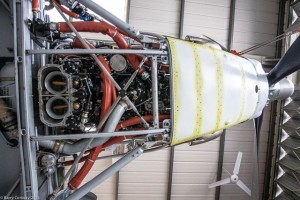 We prodded, poked, oohed and arred and peered all round the Hurricane, inside and out and the corners of the hangar bombarding Phil with questions which he happily answered whilst Barry clicked away on his super-duper camera and discovered that there was an unopened Airfix model lurking in the spares draw, clearly in case it all went Pete Tong. Hawker’s designer Sydney Camm was a firm exponent of the traditional riveted, bolted method of construction rather than the stressed skin and welded methods then being developed. This means that most of the joints are incredibly complex involving brackets and square-formed ends to the tubing. In restoration terms this makes rebuilding very time consuming but did mean that assembly was very straightforward and required only basic tools and, in active service, the system, along with the fuselage and tailplane being fabric-covered meant that damage was easily repaired. Early versions had fabric covered wings but these were largely replaced by duralumium stressed-skinned ones by the Battle of Britain. Peering down the insides of the fuselage and the leading and trailing edges revealed the high standard of build that has gone into this aircraft. The attention to detail is astonishing.
We prodded, poked, oohed and arred and peered all round the Hurricane, inside and out and the corners of the hangar bombarding Phil with questions which he happily answered whilst Barry clicked away on his super-duper camera and discovered that there was an unopened Airfix model lurking in the spares draw, clearly in case it all went Pete Tong. Hawker’s designer Sydney Camm was a firm exponent of the traditional riveted, bolted method of construction rather than the stressed skin and welded methods then being developed. This means that most of the joints are incredibly complex involving brackets and square-formed ends to the tubing. In restoration terms this makes rebuilding very time consuming but did mean that assembly was very straightforward and required only basic tools and, in active service, the system, along with the fuselage and tailplane being fabric-covered meant that damage was easily repaired. Early versions had fabric covered wings but these were largely replaced by duralumium stressed-skinned ones by the Battle of Britain. Peering down the insides of the fuselage and the leading and trailing edges revealed the high standard of build that has gone into this aircraft. The attention to detail is astonishing. 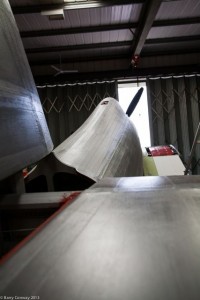 Throughout the restoration which did use some new parts such as the centre-section anomalies keep cropping up. The original canopy wouldn’t fit properly. They soon realised that the wooden stringers that formed the profile of the upper fuselage was clearly wrong. Borrowing a set from the Memorial Flight it soon became apparent that the ones that had been made up were miles out. Off it all came and the correct shape was recreated. Now all is well but it was a lot of work that hadn’t been expected. Then they discovered that the engine cradle was slightly out giving the engine a slight nose-down attitude. Bummer. Out it all came, the cradle was rebuilt to the correct specification and the whole lot refitted. This then meant that all the cowlings were now out so they all had to be re-made.
Throughout the restoration which did use some new parts such as the centre-section anomalies keep cropping up. The original canopy wouldn’t fit properly. They soon realised that the wooden stringers that formed the profile of the upper fuselage was clearly wrong. Borrowing a set from the Memorial Flight it soon became apparent that the ones that had been made up were miles out. Off it all came and the correct shape was recreated. Now all is well but it was a lot of work that hadn’t been expected. Then they discovered that the engine cradle was slightly out giving the engine a slight nose-down attitude. Bummer. Out it all came, the cradle was rebuilt to the correct specification and the whole lot refitted. This then meant that all the cowlings were now out so they all had to be re-made. 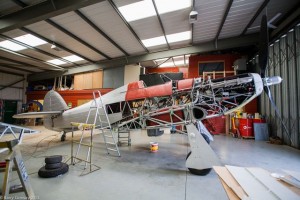 The latest headache was the need to find a spinner for the prop. RCAF, and other national examples of Hurricanes often flew without the spinner and finding one of the correct size and profile is harder than you’d think. They tried one from a Constellation which nearly fitted but now they have ‘borrowed’ one from a static example and will cast a Kevlar copy for the owner and keep the original thanks to the barter system that seems to work well. Such are just some of the problems that surround such a huge undertaking. Phil lives Hurricanes and now there is very little he doesn’t know about them, especially the way to source parts, so close has he got.
The latest headache was the need to find a spinner for the prop. RCAF, and other national examples of Hurricanes often flew without the spinner and finding one of the correct size and profile is harder than you’d think. They tried one from a Constellation which nearly fitted but now they have ‘borrowed’ one from a static example and will cast a Kevlar copy for the owner and keep the original thanks to the barter system that seems to work well. Such are just some of the problems that surround such a huge undertaking. Phil lives Hurricanes and now there is very little he doesn’t know about them, especially the way to source parts, so close has he got.
 As for his original one, sitting rather forlornly at the back of the hangar, once this one is out the way then he will crack on with it. The engine is all ready to go and most of the parts, all proper British made, have been sourced or borrowed to make copies from. Built in early 1941 by Gloster, it is an authentic British example of the Hurricane IIB. Rescued from Murmansk it was one of the first to fly off the aircraft carrier HMS Argus landing in Russia on 7th September 1941. Historical notes show it served with 81 Squadron as part of 151 Wing Russia and carried the F code. Following a crash whilst on active service it was salvaged from the Kola Penninsula, Russia during 1994-5 and apparently purchased by a Swiss individual who planned to restore it in Hungary.
As for his original one, sitting rather forlornly at the back of the hangar, once this one is out the way then he will crack on with it. The engine is all ready to go and most of the parts, all proper British made, have been sourced or borrowed to make copies from. Built in early 1941 by Gloster, it is an authentic British example of the Hurricane IIB. Rescued from Murmansk it was one of the first to fly off the aircraft carrier HMS Argus landing in Russia on 7th September 1941. Historical notes show it served with 81 Squadron as part of 151 Wing Russia and carried the F code. Following a crash whilst on active service it was salvaged from the Kola Penninsula, Russia during 1994-5 and apparently purchased by a Swiss individual who planned to restore it in Hungary.  Somehow it ended up in the UK where it was registered G-BYDL and eventually bought by Phil. Incredibly, at a Russia/151 Wing Event held at RAF Duxford in October 2009, Phil was introduced to Dave Anson the son of the pilot Peter ‘Avro’ Anson who had flown it from HMS Argus to Vaenga in 1941. Dave still had all his dad’s old logbooks so he
Somehow it ended up in the UK where it was registered G-BYDL and eventually bought by Phil. Incredibly, at a Russia/151 Wing Event held at RAF Duxford in October 2009, Phil was introduced to Dave Anson the son of the pilot Peter ‘Avro’ Anson who had flown it from HMS Argus to Vaenga in 1941. Dave still had all his dad’s old logbooks so he  invited him down to meet his dad’s old Hurricane and Phil got the opportunity to take photographs of all the relevant pages of the logbooks so he now has a pretty complete record of this Hurricane’s history.
invited him down to meet his dad’s old Hurricane and Phil got the opportunity to take photographs of all the relevant pages of the logbooks so he now has a pretty complete record of this Hurricane’s history.
Tricky choice then when it comes to painting it up but he has decided that when it is completed it will sport Finnish colours. A Hurricane sporting blue Swastikas, that’ll get tongues wagging! We think its doubtful if this one will be for sale and will probably end up living with him in Finland.
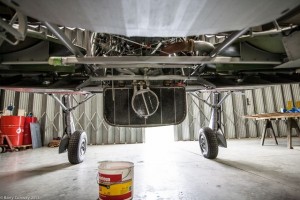 Accidently, whilst looking for a Chipmunk, Phil now also has a Harvard, well Texan actually, to build up experience ready to convert to the Hurricane. As for the one he is lavishing so much time on at the moment he has decided not to fly it but save that thrill for his own. As he pointed out, it would be a shame if he dinged it before it was sold. Favourite bits. There is a pull down step just aft of the wing that when operated by your flying boot opens a small hand hold on the side of the fuselage. There it was all working with a new bit of bungey. The complex radiator that doubles as an oil-cooler all built to the original specification. The 100 grade hex-beams that form the main frames. The pre-made timber frames over the fuselage that carries the fabric and, well, all of it really. The construction of these aircraft were truly a work of art and this one is exceptional.
Accidently, whilst looking for a Chipmunk, Phil now also has a Harvard, well Texan actually, to build up experience ready to convert to the Hurricane. As for the one he is lavishing so much time on at the moment he has decided not to fly it but save that thrill for his own. As he pointed out, it would be a shame if he dinged it before it was sold. Favourite bits. There is a pull down step just aft of the wing that when operated by your flying boot opens a small hand hold on the side of the fuselage. There it was all working with a new bit of bungey. The complex radiator that doubles as an oil-cooler all built to the original specification. The 100 grade hex-beams that form the main frames. The pre-made timber frames over the fuselage that carries the fabric and, well, all of it really. The construction of these aircraft were truly a work of art and this one is exceptional.
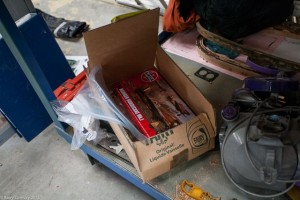 We bade our farewells to this amazing aeroplane and adjourned to the local George Inn where a fine lunchette and pint of Ringwood was enjoyed and chatted about Phil’s Texan (Harvard variant to the un-initiated) and expressed an interest in returning for the next engine run. It had been truly eye-opening and we are most grateful for the opportunity to get such a personal insight into what is clearly a deep passion. Big thanks then to Jeff for the heads up and Phil for his time, patience and understanding..
We bade our farewells to this amazing aeroplane and adjourned to the local George Inn where a fine lunchette and pint of Ringwood was enjoyed and chatted about Phil’s Texan (Harvard variant to the un-initiated) and expressed an interest in returning for the next engine run. It had been truly eye-opening and we are most grateful for the opportunity to get such a personal insight into what is clearly a deep passion. Big thanks then to Jeff for the heads up and Phil for his time, patience and understanding..
Pictures courtesy Barry Conway. Clicking on the images will/should enlarge them.
To see the engine test runs have a squint at;
https://www.facebook.com/pages/Phoenix-Aero-Services/235583393252946
If you fancy buying it check out;
http://www.platinumfighters.com/#!hurricane-iib/c6y6
Finnish Hurricanes;